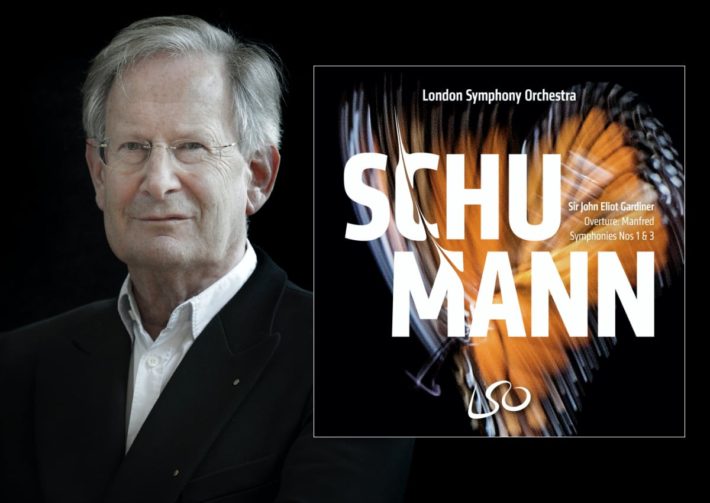Image: Sim Canetty-Clarke
This is the second half of Gardiner and LSO’s Schumann cycle, the first half has been covered here. Gardiner recorded a lauded cycle with his Orchestre Revolutionnaire et Romantique on period instruments at the turn of the century, and in revisiting the symphonies with London Symphony Orchestra, the conductor continues to press his case for Schumann’s importance, as he emphasizes in an interview contained in the booklet.
The strong points of the first Volume reappear here, these features by now quintessential, trademark Gardiner. The strings play sans vibrato and with meticulous rhythmic precision; hard sticks on the timpani and strong accents from low brass provide firm punches. The orchestra’s power doesn’t come from its depth but its agility. These are Gardiner’s tools, and with them he crafts his argument.
The case is particularly strong in the first symphony, “Spring”. Take the opening fanfare, the blossoming of the season that the rest of the symphony depicts. The typical interpretation, for example from Kubelik and the Berlin Philharmonic, is grandiose and a bit overinflated for what follows in the rest of the first movement, a light, dotted theme and ever-shifting harmonies. Gardiner’s opening is more modest, the sforzandos quick, the winds nimble, and so what follows makes more sense. The music builds to a dramatic, unusual recapitulation, and then, having earned it, Gardiner has no qualms about putting on a show (track 1, 7’16”), with the LSO providing ample fireworks. Kubelik and Berlin sound restrained and a bit imprecise by comparison. When Gardiner reaches the extended coda, a gentle tempo kick and great accents from the strings make for an exciting close.
Lest you think that Schumann (or Gardiner, or LSO) is a one-trick pony, listen to the different world that the following Larghetto inhabits. Gardiner takes the suggested tempo marking, providing more of a Beethoven-like Andante. In the orchestra, a certain fluidity of dynamic reigns on long notes (essentially the baroque messa di voce, but more tasteful), and sforzandi become luxurious and soft.
The symphony’s Scherzo is the best track on the disc, both for its catchy tune and its humor. The tune brings to mind a heavy dance, and the strings indulge in plenty of rubato to provide the illusion of weight on the downbeats. Gardiner’s grand pauses in the trio give the impression of all the dancers striking a pose, and the coda seems to depict everyone laying down for a nap. The finale that closes the symphony is equally vivid.
Related Classical Music Reviews
- Review: Schumann – Symphonies No. 2 and 4 – LSO, Gardiner
- Review: Bach – Violin Concertos – Debretzeni, Gardiner
- Review – Brahms – Symphonies No. 1 and 3 – Gardner
Schumann’s third symphony (“Rhenish”) is less classical in character than the first, but Gardiner’s clean-shaven approach is still effective. The first movement and its noble, upward leaps sparkle. The horn playing is wonderfully clean and crisp, and superbly recorded. The Scherzo feels particularly un-joke-like in Gardiner’s hands, the winds playing with fine legatos but avoiding any notion of exaggeration. Only at the very end do the horn gestures add a bit of comic relief.
The symphony’s third movement, a gentle interlude, gives way to the much darker fourth, labeled “Solemnly” and set in Eb minor, the work’s emotional core. The trombones intone a chorale opening, and launch a tutti exploration of minor and diminished harmonies, replete with suspensions and counterpoint. When people disparage Schumann for “thick orchestrations” and “lumbering rhetoric” (as New York Times’ John Rockwell wrote in 1986), this movement may be at the forefront of their thoughts. Indeed, many recordings struggle, but oddly, they go far slower than Schumann’s requested 54 bpm. Gardiner takes it around 56, and the issues seem to resolve themselves. Of course, the truth is more complex: the LSO players bring out the important lines and let others fall to the background, and there is doubtless some digital magic helping the counterpoint shine through. Gardiner deserves credit for crafting emotional lines without the help of vibrato. The finale is, musically speaking, a bit bland, but LSO and Gardiner do not let up, and the tutti arrival that leads into the coda managed to give this listener some good shivers.
This album gets better with each successive listening. Gardiner takes all the right turns and LSO’s playing sounds superb, despite the recording coming from a live performance in an acoustically subpar hall. Listeners in search of more traditional versions might head to Kubelik, Rattle, or Szell. That said, Gardiner’s way may soon become a tradition.

Schumann – Symphonies No. 1 and 3
London Symphony Orchestra
John Eliot Gardiner – Conductor
LSO Label, CD LSO0844
Albums Mentioned In This Review
Read more classical music reviews or visit The Classic Review Amazon store
Follow Us and Comment:
Get our periodic classical music newsletter with our recent reviews, news and beginners guides.
We respect your privacy.








